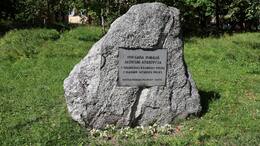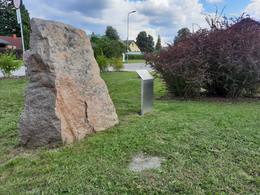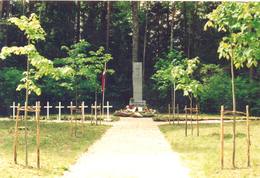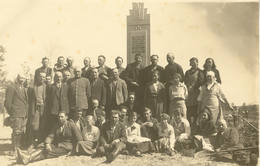Anšlavo Eglīčio prisiminimai apie Latvijos nepriklausomybės karą ir 1919 m. įvykius Alūksnėje
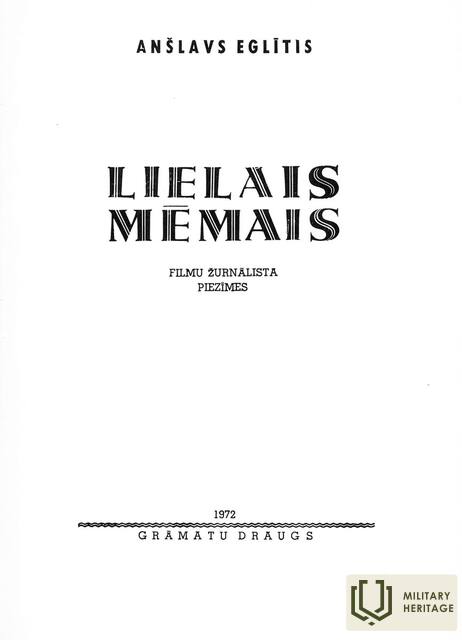
1919 m. kovo 27 d. 1-asis Valmieros pėstininkų pulkas kartu su Talino (tuometinio Rėvelės) ir Tērbato Estijos gvardijos (kaitselit) batalionais bei trimis šarvuočiais traukiniais pradėjo Latvijos išlaisvinimą nuo bolševikų nuo Melnupės upės krantų.
„Tuo metu kariuomenės ir valdžios pasikeitimas teikė daug pramogų. Vokiečiai, baltarusiai, raudonieji rusai, estai, suomiai, net danai su gražiais, iki kelių siekiančiais batais. Viena tokia scena ypač giliai įsirėžė į mano atmintį. Nelaimingi latvių šauliai, likę raudonųjų pusėje, nedidelė grupelė, ilgą dieną laikė Alūksnę prieš dvi suomių savanorių kuopas, kurios atėjo į pagalbą estams. Raudonųjų rusų batalionas, ankstyvą rytą apimtas visiškos panikos, puolė per Alūksnę, pasukdamas į rytus. Daugelis rusų bėgo be ginklų, todėl žybčiojo tik jų valenkai, o ilgi paltai plazdėjo ore. Kiekvieną akimirką tikėjomės atvykti suomių, kurie turėjo galingų, „monstriškų“ karių reputaciją. Bet nieko neįvyko. Maži miesteliai... Kitoje kalvos pusėje aidėjo šūviai, barškėjo kulkosvaidžiai. Klausėmės, ar šūviai taip pat aidėjo į dešinę ir į kairę, o tai reikštų vengimo manevrą, bet tvirti suomiai tikriausiai jau puolė tiesiai į Alūksnę. Tai tęsėsi visą dieną iki...“ Sutemo. Tada stojo tyla. Po kurio laiko bažnyčios aikštėje pasirodė šauliai. Apie penkiolika, ne daugiau. Nebuvo girdėti nei įsakymų, nei žodžių. Nulenkę galvas kaip pavargę darbininkai, nešdamiesi įrankius ant pečių, jie lėtai, ramiai ėjo pro mūsų namo langus link ežero kelio, vedančio per užšalusią lygumą. Vienam iš ėjojų galva ir ranka buvo sutvarstytos. Kitas šlubavo kruvina koja. Sunkiau sužeistas bendražygis buvo tempiamas ratiniu „Maxim“ kulkosvaidžiu. Jo nukarusi galva lingavo pagal žingsnių ritmą... Šaulių didvyriškumas turėjo ypatingos ironijos. Jie dengė rusų užkariautojų, kurie buvo priešiški jų tautai, atsitraukimą. O kur jie patys atsitraukė? Toli nuo savo žemės, į svetimą žemę, kur jų visai nelaukė dėkingumas, o tik įtarumas, pavydas, represijos ir likvidavimas. (..) Pagaliau, vėlyvą pavasarį, su drąsia daina lūpose, drąsūs Latvijos kareiviai įžygiavo į Alūksnę. Pasilikti!
Anšlavas Eglītis. „Didysis nebylys“. // Latvijos jaunimas, 1991 06 12, Nr.59.
Susijusi laiko juosta
Susijusios temos
Susijusios vietos
Atminimo akmuo Alūksnės išvaduotojams
Įsikūręs Alūksnėje, Helēnas ir Alsviķu gatvių sankirtoje.
Atminimo akmuo buvo atidengtas 1999 m. gegužės 29 d., minint Alūksnės išvadavimo 80-ąsias metines. Akmens drožybos darbus atliko skulptorius Ainārs Zelčs.
1919 m. kovo 31 d. Tartu mieste buvo įkurta Šiaurės Latvijos brigada, kurios užduotis buvo išlaisvinti Vidžemę ir Latgalą. Brigadą sudarė jungtinis 1-asis Valmieros ir 2-asis Cėsių pėstininkų pulkai, vėliau ir Šiaurės Latvijos partizanų pulkas, du kavalerijos eskadrilės ir dvi artilerijos baterijos. Gegužės 26 d. šios pajėgos užėmė Valmierą, tačiau gegužės 27 d. 1-asis Valmieros pėstininkų pulkas kartu su 2-uoju Estijos kavalerijos pulku pradėjo puolimą Alūksnės kryptimi. Bolševikai nesugebėjo atremti tolesnių atakų, todėl 1919 m. gegužės 29 d. Alūksnė buvo išlaisvinta.
Atminimo akmuo suomių savanorių pulkui „Šiaurės berniukai“
Įsikūręs Alūksnėje, Jāņkalna gatvėje 52, šalia Alūksnės siaurojo geležinkelio stoties.
2019 m. vasario 23 d., minint Latvijos Nepriklausomybės karo šimtmetį, Nepriklausomybės kovos tradicijų asociacijos (Suomija) iniciatyva buvo sukurta speciali atminimo vieta Suomijos savanoriams, žuvusiems už Latvijos nepriklausomybę, pagerbti, kurioje istorinius įvykius liudija specialus riedulys ir informacinė lenta. Atminimo akmuo į Alūksnę atkeliavo iš Suomijos – Salpos linijos, kuri buvo nutiesta 1940–1944 m., siekiant apsaugoti rytinę Suomijos sieną. 1200 km ilgio Salpos linija yra viena žymiausių nepriklausomos Suomijos gynybos linijų, taip pat vienas stipriausių ir geriausiai išsilaikiusių tokio tipo gynybos statinių Europoje po Antrojo pasaulinio karo.
Į Alūksnę atgabentas akmuo simbolizuoja dviejų tautų – suomių ir latvių – kovą už savo nepriklausomybę. Suomijos savanorių pulkas „Šiaurės berniukai“ išvyko padėti latviams ginti naujosios Latvijos valstybės laisvę. 1919 m. vasario 21 d. „Šiaurės berniukai“ dalyvavo įnirtingose kovose Alūksnės (Marienburgo) apylinkėse. Po penkias valandas trukusių mūšių netoli Alūksnės geležinkelio stoties suomiai užėmė Alūksnę. Šiame mūšyje žuvo 23 suomių savanoriai, daugelis buvo sužeisti.
Karvos brolių kapinės
Įsikūręs Alūksnės–Apės kelio pakraštyje, netoli Zuši mājas, į pietus nuo Karvos, ties posūkiu į Rezaką.
Paminklas atidengtas 1937 m. rugsėjo 12 d. Granito stela buvo pagaminta O. Dambekalno akmens karjere Rygoje pagal Karo statybos valdybos architekto Vemerso Vitando projektą.
1975 m. rudenį vietos komunistai paminklą sunaikino. 1989 m. kovo 30 d. Alūksnės rajono taryba priėmė sprendimą paminklą restauruoti, o 1989 m. balandžio 30 d. jo vietoje buvo įrengtas laikinas medinis paminklas – latviško antkapio formos, kurį pagamino Valstybinės elektros gamyklos (VEF) darbininkas Jānis Jaunzemsas. Ant jo buvo užrašas: „Čia bus restauruotas Karvos brolių kapinių paminklas“.
Tuo metu buvo sutvarkytos ir netoliese esančios Brolių kapinės.
1993 m. Alūksnės brolių kapinių komiteto vadovo Uldos Veldre iniciatyva buvo atnaujinti memorialinės vietos restauravimo darbai. Naująjį paminklą pagamino Cėsių akmentašiai broliai Aivaras, Austris ir Auseklis Kerliniai.
Paminklas buvo atidengtas 1994 m. birželio 11 d.
Broliškose kapinėse palaidoti keturi Valmieros pėstininkų pulko 5-osios kuopos kariai - Jēkabs Sukse, Pēteris Leitlands, Ernests Puķītis ir Gustavs Ozols, žuvę mūšiuose prie Zušių 1919 m. balandžio 2 d. Penktasis kareivis, palaidotas XX a. 4-ojo dešimtmečio viduryje, buvo Roberts Glazners, Valmieros pulko karys, dingęs be žinios 1919 m. kovo 31 d. netoli Jaunosios muižos. Iš pradžių jis buvo palaidotas kaip nežinomas, tačiau vėliau jo vardas buvo patikslintas ir iškaltas paminkle. Savo ruožtu penktasis Zušių mūšyje žuvęs karys Augusts Dzedons (Ziedons) palaidotas Apekalnos kapinėse.
Prie paminklo papėdėje įrengta atminimo lenta Ungurių mūšio dalyviui Janiui Goldesui (1891–1952), žuvusiam komunistų koncentracijos stovykloje Intoje, Komijoje.
Antroji atminimo lenta, atidengta 1992 m. rugpjūčio 23 d., yra įrengta prie vieno iš medinių kryžių ir skirta 7-ojo Siguldos pėstininkų pulko kapralui Pēteriui Jansonui, kurį 1941 m. liepos 7 d. nužudė pasitraukiantys komunistai.
Paminklas Onos parapijos kariams, žuvusiems Pirmajame pasauliniame kare ir Latvijos išsivadavimo kare
Įsikūręs Anos parapijos Ezerinių kapinių centrinėje dalyje.
Kapinėse, kuriose laidojami nuo 1925 m., stovi paminklas, pastatytas iš Anos parapijos Sargybos skyriaus surinktų lėšomis ir 1933 m. atidengtas, skirtas Anos parapijos kariams, žuvusiems Pirmajame pasauliniame kare ir Latvijos išsivadavimo kare. Iki Antrojo pasaulinio karo paminklo priežiūra rūpinosi Anos parapijos sargybiniai, kurie kiekvieną sekmadienį eidavo į kapines ir, pagerbdami žuvusiuosius, dėdavo gėlių. 1940 m. lapkričio 18 d. paminklas buvo nugriautas, kulkų palikti pėdsakai vis dar matomi. Šiomis dienomis kapinėse kasmet rengiami Lačplėsio dienai skirti minėjimai.
2004 m. kapinėse atidaryta atminimo vieta 1941 ir 1949 m. politiškai represuotiems asmenims, o 2006 m. – atminimo lenta nacionaliniams partizanams.





